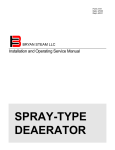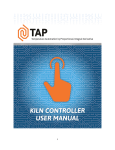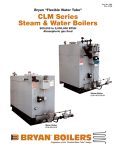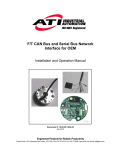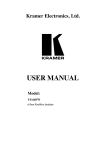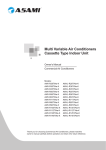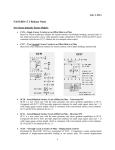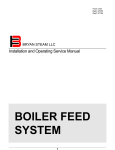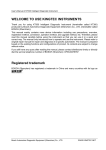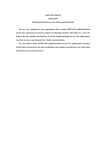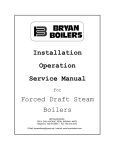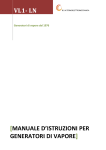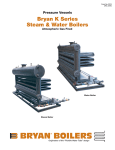Download SECTION 1 - Bryan Boilers
Transcript
Installation Operation Service Manual for Electric Steam Boilers BRYAN BOILERS P.O. BOX 27, PERU, INDIANA 46970 Telephone: 765-473-6651 / Fax: 765-473-3074 E-Mail: [email protected] / Internet: www.bryanboilers.com INSTALLATION INSTRUCTIONS SECTION 1 Date: 10/1/97 FOR Revision: New ELECTRIC STEAM BOILERS Form: 2055-1 NOTE: ? ? Please read the entire instruction manual before attempting installation. Insurance, Local and/or State regulatory codes may contain additional or more stringent requirements than those contained in this manual. Installation must conform to these codes2 and any other authority having jurisdiction. Appropriate sections of NEC should be consulted and followed. ? 1.1 BOILER FOUNDATION Before uncrating, the boiler location should be prepared. The boiler should set upon a good level concrete floor. If the boiler is not level or the floor in good condition, a concrete foundation should be built, utilizing dimensions larger than the outside dimensions of the boiler base. 1.2 CLEARANCES The front of the boiler should not be any closer than 36" from any obstruction for servicing the electrical panels. The element end of the boiler should not have any obstruction for the same length as the boiler supplied for removal and servicing of elements. The back of the boiler (as long as panels are not supplied in the rear) can be mounted next to an obstruction. Local codes must be applied to specific installations 1.3 and the minimum clearances established accordingly. Provisions must also be made for service, accessibility, and clearance for piping and electrical connections. NOTE: ADHERE TO ALL APPLICABLE LOCAL CODES AND NEC REGARDING BOILER INSTALLATION AND CLEARANCES. UNCRATING THE BOILER Uncrate the boiler near its permanent location. Leave it on the bottom crating until ready to place permanently. Leave the plastic shroud on the boiler until all piping work is complete; cutting holes in the plastic for access to connections. Remove the bolts attaching the boiler to the crate at the underside of the bottom crating. Lift or slide the boiler off of the bottom crating into position. Be careful not to tip the boiler up on one corner or side, which could cause damage to the jacket. 1.4 1.4-1 BOILER CONNECTIONS GENERAL 1.4-4 SAFETY RELIEF VALVE(S) Do not run any pipes along the element access and power panel side of the boiler. Maintain clearances as shown on the dimensional drawing for servicing and as referenced in NEC. All piping should be designed and installed to avoid any loadings on the boiler connections or piping. A connection is provided in the top of the boiler for the relief valve. The relief valve discharge piping must be the same size as the relief valve discharge opening. Avoid overtightening as this can distort valve seats. All piping from relief valve must be independently supported with no weight carried by the valve. 1.4-2 1.4-5 FLOW CONNECTIONS A steam shut-off valve must be installed between each boiler and the steam main. This valve must be of the outside screw and yoke design to allow indication from a distance whether the valve is open or closed. 1.4-3 FEEDWATER CONNECTION Install a check valve and a globe valve between the feed pump and the boiler. It is also recommended to install a globe valve between the feed pump and the receiver tank. This valve can then be adjusted to bypass excess pump capacity to better control the boiler feed rate. 1.5 BLOWDOWN CONNECTION Blowdown valve(s) must be full size of the connection on the boiler. Steam boilers 15 psig and below require at least one blowdown valve. Higher pressure boilers require two blowdown valves with one or both valves being slow opening type. Each water column and float type low water cut-off must be equipped with a blowdown valve. ELECTRICAL CONNECTION All electrical connections must conform to the NEC and to all other applicable State and Local Codes. IMPORTANT: The heating elements supplied with Bryan electric boilers are of the resistance type with an incoloy sheath and a watt density not exceeding 75 watts/square inch. These elements are typically delta wired unless otherwise specified. Power supply voltage must be as shown on the wiring diagram enclosed. A fused main disconnect switch must be supplied per NEC requirements. Wiring to the main power terminals in the power panel by the contractor must have current carrying capacity equal to at least 125% of the amperage rating of the boiler. The lugs supplied are at the top of the power panel and suggested entrance can be recognized on the dimensional. The boiler must be grounded in accordance with the NEC, ANSI/NFPA #70-1981. EQUIPMENT GROUNDING: ALL CONTROL PANELS AND CONTROLS ARE SUBJECT TO SOME INTERNAL HEAT. CAUTION: ADEQUATE BOILER ROOM VENTILATION MUST BE PROVIDED. 1.6 1.6-1 BOILER ACCESSORY EQUIPMENT ELEMENTS The immersion type electric resistance heating elements are mounted in a standard 150# flange (300# flange if required). These elements are held into this flange with brass fittings. Each element hairpin is rated at 5 KW or 10 KW at the rated volts. The incoloy sheath is a nickel, chrome and iron alloy, which provides good resistance to oxidation and has good strength characteristics at elevated temperatures. By virtue of its very high nickel content, the material does not have a tendency to become embrittled after prolonged exposure to temperatures. Corrosion resistance of the incoloy is attributed to the chrome and nickel content of the alloy. This type of material was chosen as a sheath material because of its resistance to corrosion oxidizing conditions and attacks from impurities in the various water conditions. Each element is easily replaced by using ordinary hand tools. This eliminates the necessity of having a complete element bundle as spare parts and also eliminates the necessity of returning the element bundle to the manufacturer for repair, although this service is available. 1.6-2 BOILER COMPONENTS - GENERAL The boiler equipment list in this manual lists the components supplied with this boiler. A description of the major components follows, however, detailed information can be found in each manufacturers literature data. 1.6-3 POWER PANEL WIRING These circuits are broken down into branch circuits of no more than 50 amps per circuit. A distribution lug in the BE Series and a copper bus bar in the BH Series is used to branch the power to individual fuses and contactors in each branch circuit. Each leg in each circuit is individually fused with fast acting fuses to interrupt power if required. The contactors are then wired using high temperature wire to each element circuit and bundle located in the element flange discussed earlier. 1.6-4 CONTROL CIRCUIT WIRING The control circuit voltage is 120 V, single phase, and fed from a step down transformer (if provided). The transformer=s primary side is connected to two fuses located in the power panel. One side of the secondary is grounded and the other side feeds the control circuit through the control circuit fuse. All of the safety controls are wired in series so that any one of the safety controls will shut down the boiler if the limit is reached. Also, located in the control circuit is a recycle relay (in some cases the relay is built into the sequencer). In case of power failure, the function of this relay is to eliminate a sudden power load on the distribution system. If a power failure occurs, the recycle relay interrupts the control circuit power causing the magnetic contactors to drop out. Power is shut off to the elements until the modulating motor has driven the sequencer back to its original starting position. The relay is then activated, and the sequencer will bring the steps back on one at a time until the system is again balanced. There is also a limit supplied to be installed with the shunt trip on the main circuit breaker in order to completely shut down all power to the boiler. Refer to your electric wiring diagram supplied. 1.6-5 SAFETY RELIEF VALVES The safety relief valves are mounted on the top of the boiler. These are a final safety device in case the operator and other safety devices fail. Such a failure will cause the pressure to rise in the boiler to the set pressure of the relief valve. The relief valve will discharge, so that the boiler will not be able to generate pressure beyond the set pressure of the relief valve. 1.6-6 LOW WATER CUT-OFF The function of the low water cut-off is to shut down the boiler if for any reason the water level should drop below the normal operating range. 1.7 1.7-1 PROCEDURES TO BE FOLLOWED BEFORE PLACING BOILER IN OPERATION HYDROSTATIC TEST OF BOILERS & SYSTEM After completing the boiler installation, the boiler connections, fittings, attachments and adjacent piping must be inspected for leaks by filling the unit with water. The pressure should be gradually increased to a pressure just below the setting of boiler safety relief valve(s). Remove the boiler access panels (see dimensional drawing in this manual). Inspect all openings and fittings for any leaks. Although the boiler is hydrostatically tested at the factory, minor leaks in fittings and attachments can develop from shipping vibrations or from installation procedures. It is often necessary to re-tighten such fittings after installation and after the boiler has been in operation for some time. Replace panels before starting boiler. START-UP AND OPERATION Section 2 Date: 10/1/97 FOR Revision: New ELECTRIC STEAM BOILERS Form: 2055-2 WARNING: IMPROPER SERVICING AND START-UP OF THIS EQUIPMENT MAY CREATE A POTENTIAL HAZARD TO EQUIPMENT AND TO OPERATORS OR PERSONS IN THE BUILDING. SERVICING AND START-UP MUST BE DONE ONLY BY FULLY TRAINED AND QUALIFIED PERSONNEL. CAUTION: BEFORE DISCONNECTING OR OPENING ANY BOILER ITEMS OR ACCESSORIES, BEFORE CLEANING OR REPLACING PARTS OF ANY KIND, TAKE THE FOLLOWING PRECAUTIONS: 1. TURN OFF AND LOCKOUT ALL ELECTRICAL DISCONNECTS TO THE BOILER AND ANY OTHER EQUIPMENT OR SYSTEMS ELECTRICALLY INTERLOCKED WITH THE BOILER. 2. ALL COVER PLATES, ENCLOSURES, AND GUARDS MUST BE IN PLACE AT ALL TIMES EXCEPT DURING MAINTENANCE AND SERVICING. 2.1 2.1-1 LIMIT CIRCUIT CUT-OUT TEST PROTECTIVE DEVICES All operating and limit controls, and low water cutoffs must be tested for proper operation. 2.1-2 STEAM PRESSURE OPERATING CONTROL The steam pressure in the boiler is regulated by the Boiler Operator. This is a pressure control which senses the steam pressure and turns the boiler on and off accordingly. This control must be operationally tested. Adjust the pressure setting on the control to a pressure less than the boiler pressure (as shown on the boiler pressure gauge). The control should turn the boiler off. Restore the control setting to normal. The boiler should cycle on. 2.1-3 HIGH LIMIT CONTROL At least two additional temperature controllers are provided as high limit controls. They are set at a pressure above the operator to act as a back-up should the operator fail. The high limit control must be operationally tested. With the boiler operating, decrease the pressure setting of the limit control below the current pressure of the boiler. The boiler should cycle off. Restore the high limit control setting to normal (pushing the reset button if it is a manual reset type). The boiler should now cycle on. 2.1-4 COIL LIMIT CONTROL On indirect water heating boilers, an additional temperature limit control is installed to limit the temperature leaving the heat exchanger. It must be tested in the same manner as the boiler High Limit control. 2.1-5 LOW WATER CUT-OFF(S) Most boilers are supplied with at least one float operated primary low water cut-off (and pump control or water feeder combination) and electric probe type control, designed to sense the level of the water in the boiler. It operates to shut off the boiler if the water level drops below its sensing level. The low water cut-off controls must be operationally tested by manually lowering the boiler water level by opening the drain valve. The boiler should cycle off when the water level drops below the control point of the low-water cut-off. When the water level is restored, the boiler should cycle back on. Depress the manual reset button of devices which require manual reset in order to restore the boiler to operation. Carefully read the enclosed literature on the low water cut-off controls, particularly installing, operating and servicing. Additional controls, as required for the particular installation, may also be provided. Refer to the literature on these devices included in the boiler manual. All such devices must be operationally tested to assure reliable operation of the boiler and system. 2.1-8 2.1-6 COMBINATION LOW WATER CUT-OFF & FEEDER The low water cut-off/feeder supplied with some boilers serves as a low water cut-off (see above) and also causes make-up water to be added to the boiler, should the water level drop below its control point. This type of control must be operationally tested to assure that the make-up water is introduced as needed. Carefully read the enclosed literature on the low water cut-off controls, particularly installing, operating and servicing. 2.1-7 2.2 BOILER FEED SYSTEM The boiler feed pump must be operationally tested to assure that it can provide boiler feedwater at the pressure and in the amount needed for safe and reliable boiler operation. 2.1-9 CHEMICAL FEED SYSTEM & SOFTENER Check the performance of the boiler water softener and chemical treatment system. Chemically test the feedwater to be certain it complies with the recommendations of the chemical treatment consultant. OTHER CONTROLS OPERATING CONTROLLER As previously discussed, electric boilers are broken down into branch circuits. Each circuit is controlled by a step control (if two steps or less, then controlled by their own pressure control). Step control operates by having a signal sent from the operating control that typically sends a modulation signal depending on the pressure setting at the pressure operating control. The pressure operating controller will send a signal to the step control to cycle on more steps until the desired pressure is reached. Once the pressure control is satisfied, steps will begin to cycle off, therefore, turning off elements and reducing the heat output. Each step control is supplied with a dead band area. When the desired pressure is reached the step control will stay constant until a larger degree of drop is recognized. This will keep the step controller from oscillating between steps during operation. The operating control pressure needs to be set and maintained by the operator for the desired output . 2.3 2.3-1 OPERATING INSTRUCTIONS FAMILIARIZATION WITH MANUAL(S) The user of the boiler must familiarize himself with this manual to be sure he is prepared to operate and maintain the boiler properly. The operating instructions should be kept in a safe place and available to all who may be working or operating the boiler. READ THE MANUAL BEFORE CAUTION: CHECK ALL ELECTRICAL TERMINALS AND CONNECTIONS FOR TIGHTNESS BEFORE START-UP. ATTEMPTING A START-UP. 2.4 2.4-1 MAINTENANCE SCHEDULE POSTING SCHEDULE Post a maintenance schedule in accordance with the recommendations in this manual. A copy of a typical schedule is included in this manual. CARE AND MAINTENANCE SECTION 3 FOR Date: 10/1/97 Revision: New ELECTRIC STEAM BOILERS Form: 2055-2 CAUTION: ? THE BOILER AREA SHOULD BE KEPT FREE OF COMBUSTIBLE MATERIALS, GASOLINE AND OTHER FLAMMABLE LIQUIDS. ? THE FOLLOWING PROCEDURES MUST BE CONDUCTED AS OUTLINED TO ASSURE SAFE OPERATION OF THE BOILER. ? ALL COVER PLATES, ENCLOSURES, AND GUARDS MUST BE IN PLACE AT ALL TIMES, EXCEPT DURING MAINTENANCE AND SERVICING. 3.1 3.1-1 REQUIRED PRECAUTIONS DURING TEMPORARY USE GENERAL A boiler is often utilized in new construction to assist in curing of building components or to provide temporary heat for the construction crew or for other purposes during the time the building is under construction. If precautions are not taken during this time to protect the boiler, a great deal of damage can occur before the ultimate owner takes over the building. It is the mutual responsibility of the installing contractor and the boiler owner to consider the effect of temporary usage on the boiler warranty. The following should be observed so as to assure the longevity of the boiler. 3.1-2 OPERATOR SKILLS/RESPONSIBILITIES During the temporary use period, a single individual must be assigned responsibility for the care and operation of the boiler. 3.2 3.2-1 This person=s responsibility must include, but not be limited to, the following: 1. Knowledge of boiler operation. 2. Possession and understanding of boiler operating instruction manual. 3. Assurance that the boiler is fed with only treated water at all times and that chemical treatment and blowdown procedures are always followed. 4. Notification to the manufacturer (or manufacturer=s agent) to provide startup services if the boiler was purchased with start-up by a factory representative. 5. Adherence to all of the start-up procedures noted in the boiler manual. 6. Considerations of warranty should the boiler be used for temporary heat without adherence to the recommended start-up and operating procedures outlined in the instruction manuals. CLEANING THE BOILER AND SYSTEM - NEW SYSTEMS BOIL OUT PROCEDURE The internal surfaces of a newly installed boiler will have oil, grease or other protective coatings used in manufacturing. Such coatings must be removed since these coatings lower the heat transfer rate and reduce operating efficiency. The operator must be familiar with the procedure outlined in the boiler operating instruction manuals. BOILING OUT UNDER PRESSURE IS NOT RECOMMENDED. IF BOILING OUT UNDER PRESSURE IS REQUIRED, COMPETENT ASSISTANCE MUST BE PROVIDED. CAUTION: THE BOIL OUT PROCEDURE OUTLINED MUST BE PERFORMED BY, OR UNDER THE DIRECT SUPERVISION OF, A QUALIFIED TECHNICIAN. THE CHEMICALS USED PRESENT A HAZARD OF BURNS AND PHYSICAL INJURY IF MISHANDLED. ALWAYS USE SUITABLE FACE MASK, GOGGLES, PROTECTIVE GLOVES AND GARMENTS WHEN HANDLING CAUSTIC CHEMICALS. DO NOT PERMIT THE CHEMICAL TO COME INTO CONTACT WITH SKIN OR CLOTHING. ALWAYS FOLLOW THE SAFETY PRECAUTIONS ON THE CONTAINER=S LABEL. ADD CHEMICALS SLOWLY AND IN SMALL AMOUNTS TO PREVENT EXCESSIVE HEAT AND AGITATION. DO NOT ADD WATER TO ACID. DO NOT ADD WATER TO DRY CHEMICAL. THIS WILL CAUSE SPLATTERING AND/OR EXPLOSION AND SEVERE RISK OF PERSONAL INJURY. In combination with system contamination, bacteria may cause objectionable odors, sometimes resembling natural gas. It is important to keep these fumes from air Your water consultant or water treatment company will be able to recommend a cleaning or boil out procedure. In the event that such service is unavailable or as yet not selected, the following may be used. 1. 2. 3. 4. The boil out of the boiler and system is neither difficult nor expensive. The chemicals needed for cleaning are readily available. Trisodium phosphate, and sodium hydroxide (lye) are the most commonly used chemicals. Use only one type of solution in the system. The amount of chemical required will vary according to conditions, but an amount of one pound of chemical per fifty gallons of water is suggested. Before introducing the solution into the boiler, an overflow pipe should be attached to the top of the boiler and routed to a safe point of discharge. Remove all safety valves to ensure that none of the solution will come into contact with the valve seats. Use care in removing and reinstalling valves. All valves in the piping to and from the system must be closed to prevent the chemical solution from getting into the intakes which would distribute them throughout the building. On steam humidification systems this is especially critical. Consult your local water treatment chemist for further information. system. 5. Gauge glasses must be protected from contact with the boil out chemicals. 6. Fill the boiler with clean softened water until the water level reaches the upper header. Then add the cleaning solution into the upper header. Add more clean water until the boiler is completely filled. The water used for this initial fill should be at room temperature, and must be softened as noted. 7. After filling, turn the boiler on (at a low temperature) at a frequency as necessary to hold the boiler solution at boiling point temperature. DO NOT PRODUCE STEAM PRESSURE. Boil the water, supervised at all times, for at least five hours. 8. After the five hour boil out, begin to add a small amount of fresh softened water so as to create a slight overflow of the overflow pipe. This will carry out impurities which have accumulated at the water surface. Continue to apply heat and overflow until the water emitted from the overflow pipe clears. Then shut-off the boiler. 9. Let the boiler cool to 1200F or less. 10. 11. Drain the boiler. Use caution that the Remove the inspection/cleanout openings in the boiler and wash the waterside surfaces thoroughly using a high pressure water stream. Inspect the boiler=s internal (waterside) surfaces thoroughly after the procedure. If the surfaces are not clean, repeat the boil out. 12. 13. water is discharged with safety. After boil out, close all openings. Install relief valves, gauge glasses and other components as necessary. Completely fill the boiler with fresh, softened, ambient temperature water. Operate the boiler until water temperature of at least 1800F is reached. The boiler is now ready to operate. IMPORTANT: IF BOILER IS NOT TO BE OPERATED WITHIN 24 HOURS, A LAY-UP PROCEDURE IS REQUIRED. REFER TO INSTRUCTION FOR LAY-UP. 3.3 SYSTEM CLEAN OUT Many boilers have been ruined with system contaminants such as pipe dope, cutting oil, metal shavings or chips and other debris which are left in the piping. If these contaminants are not removed, they will end up in the boiler. 3.3-1 SYSTEM CLEANING PROCEDURE For steam systems, the boiler will need to be connected to the header utilizing steam to purge the piping and thus push the debris out of the system. However, at this time all condensate must be wasted until it runs clear and water analysis of the condensate indicates that it is free of contaminants. Steam trap strainers must be periodically opened and cleaned of any debris which accumulates. 3.4 3.4-1 For old or existing steam systems, the installation process may have jarred debris loose. Following the boil out of the new boiler, the condensate should be wasted until it is within proper guidelines. Check all steam trap strainers to assure their cleanliness. Refer to the succeeding section on replacement boiler installations. REPLACEMENT BOILER INSTALLATIONS: PROTECTION AGAINST CORROSION & SEDIMENT system. It will be necessary to supply such a system if not already installed. BOILER MUST CONTROL FEED WATER The water feed to the boiler must be controlled by the boiler-mounted water level control. It is unacceptable to use gravity return or to let the water feed be controlled by a condensate / receiver / condensate pump system. The water feed to the boiler must be controlled: ? During this system clean out, the boiler makeup water must be properly softened and treated. At the conclusion of the system clean out, the condensate must be reconnected. By a feed pump control which is mounted on the boiler. This control is to activate the feed pump on a boiler feed ? By an automatic water feeder mounted on the boiler. This is used only on systems requiring 100% make-up, such as humidification, steam process, etc. NOTE: IT IS NOT RECOMMENDED TO PROVIDE THE MAKE-UP FOR A CLOSED STEAM HEATING SYSTEM TO THE BOILER BY MEANS OF A WATER FEEDER. IT IS PREFERRED THAT SYSTEM MAKE-UP BE CONNECTED TO THE CONDENSATE RETURN TANK OF A BOILER FEED SYSTEM. 3.4-2 A BOILER FEED SYSTEM MAY BE USED IN CONJUNCTION WITH AN EXISTING CONDENSATE RECEIVER SYSTEM BY ALLOWING THE RECEIVER SYSTEM TO PUMP CONDENSATE INTO THE BOILER FEED SYSTEM TANK. CLEAN OR REPLACE ALL SYSTEM PIPING AND HEATING UNITS NOTE: FOR SOME OLD SYSTEMS, THERE IS A RELUCTANCE TO CLEAN THE PIPING BECAUSE OF THE POSSIBILITY OF LEAKS OCCURRING IN BADLY CORRODED LINES. SHOULD THE CUSTOMER REFUSE CLEANING, IT IS NECESSARY TO INSTALL FILTRATION EQUIPMENT. INSTALL EITHER A FIBROUS FILTER OR A CENTRIFUGAL FILTER IN THE BOILER RETURN PIPING. THIS WILL COLLECT AND REMOVE SEDIMENT FROM THE SYSTEM. A BOOSTER PUMP MAY HAVE TO BE INSTALLED AS WELL TO OVERCOME THE ADDITIONAL PRESSURE DROP INTRODUCED IN THE LINE BY THE FILTER. WHEN FILLING THE SYSTEM, PROVIDE CHEMICAL TREATMENT AS OUTLINED IN SECTION 3.5. Arrange for chemical and mechanical cleaning of the entire system. A chemical treatment company should be consulted for the proper means of this chemical cleaning. Replace any piping considered to be deteriorated beyond safe or cleanable condition. Flush the system clean, being certain to isolate the boiler. DO NOT FLUSH THE SYSTEM THROUGH THE BOILER. CAUTION: FAILURE TO PROPERLY CLEAN THE SYSTEM OR TO INSTALL MECHANICAL SEDIMENT REMOVAL EQUIPMENT CAN RESULT IN PIPE BLOCKAGE AND SEVERE CORROSION PLUS DAMAGE TO PUMPS, CONTROLS, AND AIR REMOVAL DEVICES. 3.5 3.5-1 BOILER WATER TREATMENT PURPOSE OF WATER TREATMENT Water treatment is required for satisfactory operation of the boiler. It must be devised to prevent depositing of scale and corrosion from acids, oxygen and other such harmful elements that may be in the water supply. A qualified water treatment chemist should be consulted and the water systematically treated. 3.5-2 OBJECTIVES The basic objectives of water treatment are: ? Prevent the accumulation of scale and deposits in the boiler. ? Remove dissolved gases from the water. ? Protect the boiler against corrosion. ? Maintain the highest possible boiler ? 3.5-3 efficiency. Decrease the amount of boiler down time from cleaning. CONTINUOUS MONITORING REQUIRED Water treatment should be checked and maintained whenever the boiler is operating. The boiler operator should be sure that the boiler is not operating for long periods without proper water treatment. Water treatment may vary from season to season or over a period of time. Therefore, the water treatment procedure should be checked not less than four times a year, and possibly more frequently as the local water conditions may indicate. All water introduced into the boiler should be softened and should include an oxygen removal system. This is required to remove dissolved oxygen from the water. Dissolved oxygen can cause severe corrosion in a heating system. 3.6 3.5-4 DRAINING AND REFILLING THE BOILER & SYSTEM If the system is drained and then refilled, chemical treatment is essential to treat the raw water. Use only clean, softened water. SUGGESTED MAINTENANCE SCHEDULE 3.6-1 DAILY MONTHLY ? Make visual inspection of gauges, monitors, and indicators and record readings in boiler log. Make visual check of instrument and equipment settings against factory recommended specifications. Check operation of float type low water cutoffs to ensure control is functioning. The lower piping connections of float type level controls should have a suitable blowdown valve piped into a proper discharge station. This valve should be opened periodically to allow any sludge accumulated in the control to be flushed out. Consult manufacturer=s instructions. ? ? ? 3.6-2 WEEKLY ? Confirm boiler area is free of combustible materials and has no obstructions. check all limit controls as specified in manufacturer=s manual. Check float low water cutoff as described above. Make sure all fuses are in operating order. ? ? ? 3.7 ? ? ? Make visual inspection of all wiring and components. Check float low water cutoff as described above. For those units equipped with a power burner, check low draft, fan, air pressure and damper position interlocks as specified in burner manual. Check branch circuit operation and electrical power panels and check for continuity between elements by using a continuity meter. ANNUALLY ? ? ? Check operating control, high limit and other electrical components for proper operating procedures as specified in manufacturers instructions. The elements in the boiler should be removed at least yearly for proper visual inspection. If elements need to be replaced, they should be replaced or the element bundle sent to the factory for service at this time. The boiler pressure vessel and piping should be checked annually. FLOAT-ACTUATED WATER LEVEL CONTROLS Inspect float type water level controls for proper operation. Visually inspect sight glasses for evidence of scale forming residues. Refer to section 3.8 for gauge glass maintenance. On closed steam heating systems, the float low water cutoff should be blown down by means of opening a lowdown valve on the lower connection of the cutoff once per day. On humidification or process systems, the lowdown schedule should be based on recommendation from a water treatment and maintenance program specifically designed for the boiler. At the annual inspection, all float type level controls should be disassembled, cleaned and inspected thoroughly. When re-installed, these 3.8 3.8-1 WATER GAUGE GLASSES INSTALLATION Check with the maintenance supervisor and engineering for the proper glass to be used. Compare the box and the glass label or marking to assure that the gauge glass ratings or temperature and pressure are suitable for use on the boiler. Use new gaskets when replacing glass. The gaskets used should be the same type as those originally supplied with the boiler. Make certain that the gauge glass valves are properly aligned. All bolts and nuts must be free-running and well lubricated, preferably with graphite type lubricant. Washers under nuts and bolt heads are desirable. DO NOT tighten while equipment is in operation. 3.8-2 MAINTENANCE Inspect the gauge glass regularly for any signs of clouding or scratching. In new processes, the gauge glass should be inspected daily until the need for replacement becomes apparent. This will help establish the routine inspection cycle. The gauge glass should be blown down daily so as to remove accumulated sediment from the valves. 3.9 controls must be given an operational test. 3.8-3 INSPECTION To examine for scratches, shine a bright concentrated light at about a 450 angle. Anything which glistens brightly should be inspected closely. Any scratches which glistens and will catch a fingernail, or crescent-shaped or star shaped mark is cause for replacement. This is because scratches, corrosion, chips and surface damage weaken the glass. If inner surface appears cloudy or roughened, and will not respond to cleaning procedures, this is evidence of chemical attack. If severe, this is cause for replacement. 3.8-4 REPLACEMENT OF GLASS Any glass that has been removed from its mounting in process boilers, regardless of the reason for removal, should be discarded and replaced with a new glass and gaskets. Used glasses may contain hidden damage and represent a safety hazard. Be sure that the replacement glass is suitable for service conditions. Protective shields to keep cold air, water, or falling objects from glass must be replaced. IDLE BOILER CARE AND LAY-UP Corrosion damage to boiler is often the result of improper lay-up during non-operating periods. Substantial damage can occur in only a few days in proper precautions are not taken. This damage is irreversible and will reduce boiler reliability, increase maintenance costs and eventually shorten the life of the boiler. protected by either keeping the surfaces completely dry or excluding air from the boiler. Air exclusion is accomplished either by keeping the boiler completely full of water (short term lay-up) or filling the boiler with nitrogen gas (long-term lay-up). The nitrogen gas prevents air infiltration and does not react with the metal. Idle boilers are vulnerable to attack when air contacts untreated wet metal surfaces. To prevent corrosion, the boiler metal must be In addition to the corrosion damage that occurs, the metal particles that are released will form 3.9-1 GENERAL an insulating scale on the boiler when it is returned to service. These corrosion products will accumulate on critical heat transfer areas of the boiler, increasing the potential for localized corrosion and over heating. 3.9-2 PRE-OPERATIONAL CLEANING AND LAY-UP Proper lay-up techniques must be used on an idle boiler even if it has never been in operation. Before pre-operational lay-up, the boiler must be chemically cleaned as outlined in Section 3.2 and 3.3 of this manual. This is required, as noted in this section, to remove preservatives, oil and grease from the inner boiler. Follow the short term or long term layup procedure as appropriate. 3.9-3 TAKING BOILERS OFF LINE In operation, boiler water contains suspended solids which are held in suspension due to water circulation and the action of treatment chemicals. Unless care is exercised when draining the boiler, these suspended solids settle on the tube surfaces and will air dry to an adherent deposit, sometimes requiring chemical cleaning to remove. In addition, these deposits may be misleading regarding the effectiveness of the chemical treatment program. 3.9-4 PRE-SHUTDOWN PRECAUTIONS For a period of three to seven days proper to shutdown, manual lowdown frequency should be increased. During this period, the lower conductivity limit should be below 3500 microohms per centimeter. The feed of internal treatment must be increased to maintain a specific residual concentration. Continuous lowdown (when used) should be kept to a minimum so the reduction of solids is achieved by the increased manual lowdown. 3.9-5 WASHDOWN As the boiler cannot be washed immediately, the heat in the boiler may cause baking of residual sludge. The boiler should not be drained until cooled enough to prevent this. However, never leave the boiler filled with water for any extended period of time without taking measures to prevent corrosion. 3.9-6 LAY-UP CONSIDERATIONS There are two basic methods of steam boiler lay-up; Wet lay-up and Dry lay-up. The choice of which method should be used depends on: ? The possibility that the boiler may need to be placed in operation on short notice. ? Disposal of lay-up solutions. ? Freezing potential. Wet Lay-up is recommended for relatively short outages, such as seasonal lay-up. This method has the advantage of allowing the boiler to be brought on line with short notice. But it can pose problems if there is any likelihood of freezing. Dry lay-up is recommended for longer periods of boiler shut-down or storage. But it is practical only if boiler can be drained hot (1200F to 1700F) or if external drying can be provided. 3.9-7 WET LAY-UP OF STEAM BOILERS SHORT TERM In the wet lay-up procedure, the boiler is to be filled with chemically treated water and sealed to prevent air in-leakage. Nitrogen gas under slight pressure can also be used to displace air and protect the boiler surfaces from corrosion. The following steps should be taken for wet lay-up of a boiler: 1a - Procedure for Operational Boiler: At least thirty minutes before the boiler comes off line, add the following chemicals: Sodium Sulfite - 0.5 lbs. Per 100 gallons water, Polymeric Sludge Dispersant - 0.1 lbs. Per 100 gallons water & Caustic Soda - 0.3 lbs. Per 100 gallons water. 1b - Procedure for Idle Boiler: If the boiler has never been on line or has been out of service for cleaning - select the highest quality water available to fill the boiler. Steam condensate, softened water, filtered fresh water, and boiler feedwater are generally acceptable for lay-up. Raw city water is not recommended and should not be used. Prepare the chemical solution described in (1a) in a separate tank. Adhere to the safety precautions described in Section 3.2 of this manual. Add the concentrated lay-up solution to the boiler during the time it is being filled. After the boiler is filled and the lay-up solution has been added, the boiler is to be operated for thirty minutes at low temperature to circulate and mix the chemicals. 2. - After filling, the boiler must be closed or blanked tightly. The power supply to the boiler must be cut off. Vent all air from the top of the boiler to allow complete fill with the required solution. Nitrogen gas at 5 psig may be introduced through a suitable opening to prevent air in-leakage during the lay-up period. An alternative to the nitrogen gas (see safety precautions under dry lay-up) is to install a 55 gallon drum or auxiliary vessel. This is to be fitted with a cover and filled with properly treated water. This vessel or drum should be connected to an available opening in the top of the vessel. Its purpose is to create a hydrostatic head and to allow a ready visual check of water level loss or in-leakage during the lay-up period. 3. - During lay-up, test the boiler weekly to assure the proper levels of sulfite and alkalinity. To do this, take a sample of the boiler water from the surface lowdown line or other high point. The test results should be: ? Sodium Sulfite 200 ppm minimum ? Phenolphthalein Alkalinity (as CaCO3) 400 ppm minimum If the tests indicate chemical concentration has decreased, chemical may be introduced to the boiler by putting it in the drum. Then lower the boiler water level to introduce it into the boiler. Operate the boiler at low temperature to circulate the water and mix the chemical. Repeat Step 2. Pay attention to the maintenance of the valves being used to isolate the boiler to prevent leakage and resultant dilution of the lay-up solution. 3.9-8 ALTERNATE METHOD An alternate wet lay-up method is to pipe clean continuous lowdown water from a properly treated boiler into any convenient bottom connection on the idle boiler, allowing the water to flow through the boiler and out the top (through any convenient top opening) to the sewer. This method will insure a continuous, complete fill with warm, properly treated water, it also prevents in-leakage of air by keeping the boiler slightly pressurized. It may also provide enough heat to possibly produce adequate freeze protection. 3.9-9 DRY LAY-UP OF STEAM BOILERS LONG TERM The dry lay-up method recommended requires that the boiler be drained, dried as completely as is possible, all opening and valves closed. Nitrogen gas at 5 psig is introduced to the boiler to pressurize it and prevent air inleakage. The success of the procedure depends on the thorough drying of the boiler metal surfaces after draining and the exclusion of air during the lay-up. 1. Drain the boiler before the steam pressure falls to zero. Then pressurized with 5 psig nitrogen gas through a suitable top opening during draining. The nitrogen pressure is to be maintained through draining and subsequent storage. An alternate method is to completely dry a clean boiler (by blowing hot dry air through he boiler) and then purge the air from the boiler and pressurize with 5 psig nitrogen. Be aware that all metal surfaces which are not completely dry are vulnerable to corrosion, particularly if oxygen is present. 2. If a boiler has been down for repairs and is to be laid up, it should be operated to pressurize with steam and then drained and pressurized with nitrogen as in Step 1. 3. All connections must be blanked or tightly closed. 3.9-10 RETURNING IDLE BOILER TO SERVICE After Wet Lay-Up To start an idle boiler after wet lay-up, use the following procedure: 1. the boiler was pressurized with nitrogen, disconnect the nitrogen supply source and vent the boiler.2. Using the lowdown valve, drain the boiler partially and make up with feedwater so as to dilute the chemical residuals to operating concentration levels. 3. After the boiler water concentrations CAUTION: THE USE OF NITROGEN FOR BLANKETING IS RECOMMENDED IN BOTH THE WET AND DRY LAY-UP PROCEDURES. EVEN THOUGH NITROGEN IN DILUTE QUANTITIES IN NON-TOXIC, IT WILL NOT SUPPORT LIFE. PRECAUTIONS MUST BE TAKEN BEFORE ENTERING EQUIPMENT FILLED WITH NITROGEN FOR INSPECTION OR ANY OTHER PURPOSES. THESE PRECAUTIONS SHALL BE AS FOLLOWS: ? DISCONNECTION OF NITROGEN SUPPLY LINE ? COMPLETE PURGING AND VENTING OF THE EQUIPMENT WITH FRESH AIR ? TESTING OXYGEN LEVELS INSIDE BEFORE ANY ATTEMPT TO ENTER ? ALL CONFINED ENTRY GUIDELINES APPLICABLE TO SITE MUST BE FOLLOWED APPROPRIATE CAUTION SIGNS SHALL BE POSTED AROUND THE EQUIPMENT TO ALERT PERSONAL THAT NITROGEN BLANKETING IS IN USE. A BOILER LAID UP DRY MUST BE TAGGED WITH INFORMATION THAT THE UNIT IS NOT TO BE OPERATED UNTIL THE BOILER IS PROPERLY REFILLED. and the water level are returned to proper operating conditions, the boiler can be started in the normal manner. After Dry Lay-Up To start an idle boiler after dry lay-up, use the following procedure: 1. Disconnect the nitrogen supply source and vent the boiler in a safe manner external to the building and away from air intakes. Then thoroughly purge the boiler of nitrogen with dry air. 2. The boiler was to have been cleaned before the lay up procedure. So it is necessary only to fill the boiler with properly treated water. Then proceed with start-up NOTE: OPERATING BOILERS MUST BE REMOVED FROM SERVICE TO MINIMIZE ADHERENCE OF BOILER WATER SUSPENDED SOLIDS ON BOILER METAL SURFACES. REFER TO PREVIOUS INSTRUCTIONS FOR BOILER WASHDOWN.


















